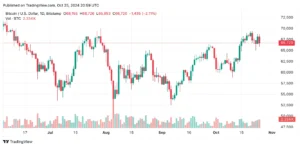1. The Volatility of the Bitcoin Market
Volatility is a defining characteristic of the Bitcoin market. Unlike traditional financial assets, Bitcoin’s price can rise or fall dramatically in a single day, often influenced by factors such as speculation, news events, and broader market trends. Here are some main causes of volatility in the Bitcoin market:
1.1 Market Sentiment and Speculation
Public sentiment heavily impacts the Bitcoin market. High-profile news, such as corporate investments or celebrity endorsements, can create significant price movements. Conversely, negative news, like exchange hacks, can spark sell-offs.
1.2 Limited Market Size
With a finite supply of 21 million Bitcoins, market demand fluctuations cause pronounced price changes. Even small movements can have a big impact, as the Bitcoin market lacks the liquidity of more mature markets.
1.3 Institutional Influence
Institutions like hedge funds and corporations are increasingly active in the Bitcoin market. Their large trades and high volumes can amplify volatility, often impacting both the short-term price and long-term market trends.
2. Regulation in the Bitcoin Market
As Bitcoin has gained global attention, governments worldwide are enacting policies that shape the Bitcoin market. Regulation can provide a framework for safer trading environments, but it also affects market growth, accessibility, and price stability.
2.1 Global Regulatory Differences
Countries differ in their approach to regulating the Bitcoin market. For instance:
- United States: The U.S. sees Bitcoin as a taxable asset, with the SEC overseeing its use in securities.
- Japan: Japan legally recognizes Bitcoin as a form of currency, providing legitimacy to the Bitcoin market.
- China: China has imposed strict regulations, including a ban on Bitcoin mining and trading. This move significantly impacted the Bitcoin market, pushing many miners to relocate.
2.2 Regulatory Trends and Their Effects on the Bitcoin Market
Regulatory decisions, such as the acceptance of Bitcoin ETFs or increased scrutiny, influence investor confidence. Positive regulatory news can attract institutional investors, while restrictive policies may deter retail traders, impacting overall Bitcoin market activity.
3. The Economic Impact of the Bitcoin Market
Beyond price and regulation, the Bitcoin market exerts a profound economic impact. It shapes sectors beyond finance, from employment and energy to the rise of digital asset management.
3.1 Financial Inclusion and Accessibility
Bitcoin allows individuals worldwide to participate in a global financial system without intermediaries, enhancing accessibility and providing financial services to underserved communities. The Bitcoin market empowers people in regions with limited banking infrastructure, offering a new way to save, invest, and transfer funds.
3.2 Job Creation and Industry Growth
The rise of the Bitcoin market has led to a surge in demand for blockchain developers, data scientists, and digital asset managers. Companies focused on cryptocurrency trading, digital wallets, and security solutions have expanded to meet this demand, contributing to economic growth.
3.3 Environmental Considerations
Bitcoin mining is energy-intensive, often raising environmental concerns. The Bitcoin market impacts energy consumption, with mining hubs consuming significant electricity. In response, there is a shift toward renewable energy sources to mitigate Bitcoin’s carbon footprint.
Conclusion: The Future of the Bitcoin Market
The Bitcoin market remains a powerful force in modern finance. Its volatility attracts risk-tolerant investors, while regulation shapes its evolution and future accessibility. Economically, Bitcoin is fostering new industries, job growth, and financial inclusion worldwide. As adoption and regulatory clarity improve, the Bitcoin market could stabilize, offering a balanced ecosystem for both speculative and long-term investment.
In sum, navigating the Bitcoin market requires a deep understanding of its volatility, regulatory landscape, and economic impacts. Staying informed about these factors is key to seizing opportunities within this dynamic and transformative market.




